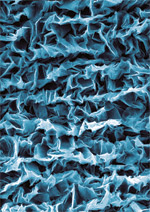Engineers from Duke University, Durham, North Carolina, have discovered a method to work with pure carbon that could lead to the creation of artificial muscles and lighter, more affordable prostheses.
The carbon, called graphene, resembles a chicken-wire lattice when under magnification, and is used in electronics, energy storage, composite materials, and biomedicine because of its unique optical, electrical, and mechanical properties. The atoms in graphene are organized like graphite, but in a sheet that is only one atom thick. While graphene has an extremely high breaking strength, it is difficult to handle because it easily “crumples.”

Crumpled graphene. Photograph courtesy of Duke University.
Xuanhe Zhao, PhD, an assistant professor in the Duke Department of Mechanical Engineering and Materials Science, compares working with graphene to the difference between unfolding paper and wet tissue. Graphene “is extremely thin and sticky and difficult to unfold once crumpled.”
To resolve the “wet tissue” crumpling problem, the team layered the graphene with acrylic elastomer, a type of rubber film sold commercially by 3M (VHB Tape 4905), that had been stretched to many times its original size. Once the rubber film was relaxed, some of the graphene detached from the rubber and still crumpled, but once the rubber film was stretched back, the graphene sections that were still adhered to the rubber pulled on the crumpled graphene to unfold it without damage.
“In this way, the crumpling and unfolding of large-area atomic-thick graphene can be controlled by simply stretching and relaxing a rubber film, even by hand,” Zhao said. “Indeed, the crumpling and unfolding of graphene allows large deformation of the artificial muscle.”
In addition, the Duke engineers layered the graphene with different polymer films to make a soft material that can act like muscle tissue by contracting and expanding on demand. When electricity is applied, the artificial muscle expands in that area; when the electricity is cut off, it relaxes.
New artificial muscles “promise to greatly improve the quality of life for millions of disabled people by providing affordable devices such as lightweight prostheses…,” Zhao said.
The results were published online in the journal Nature Materials.
Editor’s note: This story was adapted from materials provided by Duke University and Plastics Today.




